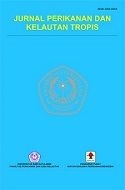Estimating Phytoplankton Abundance Using Sentinel 2A Images In Langa-Jampue Water Area, Pinrang Regency
DOI:
https://doi.org/10.35800/jpkt.v12i2.52523Keywords:
marine science, remote sensing, sentinel 2AAbstract
This study aims to estimate the abundance of phytoplankton using Sentinel-2 imagery in the Langa – Jampue water area of Pinrang Regency for Sentinel-2 image recording on February 28, 2022. This study was conducted from January – July 2022 by taking phytoplankton samples, conducting sample analysis in the laboratory, and processing Sentinel-2 image data on February 28, 2022 recording. The results of the study found 5 classes of phytoplankton, namely Bacillariophyceae, Cyanophyceae, Dyanophyceae, Peridinae, and Dinophyceae with a total of 34 phytoplankton genera and 4 dominating genera, namely Astereonolepsis, Rhizosolenia, Chaetoceros, and Ceratium. The highest phytoplankton abundance was obtained in transect 2 on point with an abundance of 977 cells/liter and the lowest abundance in transect 3 on point 24 which was 282 cells/liter. The regression test results between phytoplankton abundance and pixel band values 8, band 3, and band 2 on Sentinel-2 images produced an r-square value of 0.495 and obtained a positive correlation value between the pixel band 8 value and the phytoplankton abundance value with a correlation value of 0.529 which means that band 8 can be used for estimating phytoplankton abundance in marine remote sensing systems. The result of the paired t-test revealed that the abundance of phytoplankton based on the results of image processing and relative laboratory analysis was equal to a significant value of 0.999
Keywords: Phytoplankton, Sentinel-2 Imagery, Band 8
Abstrak
Penelitian ini bertujuan untuk mengestimasi kelimpahan fitoplankton menggunakan citra Sentinel-2 di wilayah perairan Langa – Jampue Kabupaten Pinrang untuk perekaman citra Sentinel-2 pada tanggal 28 Februari 2022. Penelitian ini dilakukan pada bulan Januari – Juli 2022 dengan mengambil sampel fitoplankton, melakukan analisis sampel di laboratorium dan mengolah data citra Sentinel-2 pada perekaman 28 Februari 2022. Hasil dari penelitian ditemukan 5 kelas fitoplankton yaitu Bacillariophyceae, Cyanophyceae, Dyanophyceae, Peridinae, Dinophyceae dengan total 34 genus fitoplankton dengan 4 genus yang mendominasi yaitu Astereonolepsis, Rhizosolenia, Chaetoceros dan Ceratium. Kelimpahan fitoplankton tertinggi didapatkan pada transek 2 yaitu pada titik 9 dengan kelimpahan 977 sel/liter dan kelimpahan terendah pada transek 3 yaitu pada titik 24 dengan kelimpahan 282 sel/liter. Hasil uji regresi antara kelimpahan fitoplankton dan nilai pixel band 8, band 3 dan band 2 pada citra Sentinel-2 menghasilkan nilai r-square yaitu 0,495 dan didapatkan nilai korelasi yang positif antara nilai pixel band 8 dan nilai kelimpahan fitoplankton dengan nilai korelasi 0,529 yang berarti band 8 dapat digunakan untuk pendugaan kelimpahan fitoplankton pada sistem penginderaan jauh kelautan. Dari hasil uji-t paired dapat diketahui bahwa kelimpahan fitoplankton dari hasil pengolahan citra dan hasil analisis laboratorium realtif sama dengan nilai signifikan 0,999
Kata kunci: Fitoplankton, Citra Sentinel-2, Band 8
References
Aiken, J., Alvain, S., Barlow, R., Bouman, H., et al (2014). Detection of Phytoplankton Size Structure by Remote Sensing Reports and Monographs of the International Ocean-Colour Coordinating Group Phytoplankton Functional Types from Space. JANUARY.
Barokah, G. R., Putri, A. K., & Gunawan, G. (2017). Kelimpahan Fitoplankton Penyebab HAB (Harmful Algal Bloom) di Perairan Teluk Lampung pada Musim Barat dan Timur. Jurnal Pascapanen dan Bioteknologi Kelautan dan Perikanan, 11(2), 115. https://doi.org/10.15578/jpbkp.v11i2.302
Gurning, L. F. P., Nuraini, R. A. T., & Suryono, S. (2020). Kelimpahan Fitoplankton Penyebab Harmful Algal Bloom di Perairan Desa Bedono, Demak. Journal of Marine Research, 9(3), 251–260. https://doi.org/10.14710/jmr.v9i3.27483
Hidayat, R., Viruly, L., Azizah, D., & Ali, R. (2013). Kajian Kandungan Klorofil -a Pada Fitoplankton Terhadap Parameter Kualitas Air Di Teluk Tanjung Pinang Kepulauan Riau. Jurnal Umrah.
Oktaviani, N., & Kusuma, H. A. (2017). Pengenalan Citra Satelit Sentinel-2 Untuk Pemetaan Kelautan. Oseana, 42(3), 40–55. https://doi.org/10.14203/oseana.2017.vol.42no.3.84
Pan, X., Mannino, A., Marshall, H. G., Filippino, K. C., & Mulholland, M. R. (2011). Remote sensing of phytoplankton community composition along the northeast coast of the United States. Remote Sensing of Environment, 115(12),3731–3747. https://doi.org/10.1016/j.rse.2011.09.011
Philips, E. J., Cichra, M., Aldridge, F. J., Jembeck, J., Hendrickson, J., & Brody, R. (2000). Light availability and variations in phytoplankton standing crops in a nutrient-rich blackwater river. Limnology and Oceanography, 45(4), 916–929. https://doi.org/10.4319/lo.2000.45.4.0916
Pratiwi, E. D., Koenawan, C. J., & Zulfikar, A. (2015). Relationship of Plankton Affairs To Water Quality In Malang Waters Meeting Of Bintan Regency, Riau Islands Province. Jurnal FIKP UMRAH, 14.
Rafsanja, UNMuh, L., Jaya, G., & Rahim, S. (2020). Analisis Perbandingan Citra Landsat 8 dan Citra Sentinel 2-A untuk Mengidentifikasi Sebaran Mangrove. 4(1).
Rahman, A., Pujiyani Astuti, L., Warsa, A., & Arifin Sentosa, A. (2021). Prediksi Tingkat Kekeruhan Prediksi Tingkat Kekeruhan (Turbiditas) Menggunakan Citra Satelit Sentinel 2A Di Waduk Jatiluhur, Jawa Barat. Jurnal Sumber Daya Air, 17(November),1–3. https://doi.org/10.32679/jsda.v17i2.697
Tambaru, R., Nafie, Y. A. L., & Junaidi, A. W. (2020). Proportion of HABs in Losari coastal waters of Makassar. IOP Conference Series: Earth and Environmental Science, 564(1). https://doi.org/10.1088/1755-1315/564/1/012018
Downloads
Published
How to Cite
Issue
Section
License
Copyright (c) 2024 Siti Asmutianti Muhtar, Muhammad Anshar Amran, Muh. Hatta

This work is licensed under a Creative Commons Attribution-NonCommercial 4.0 International License.











